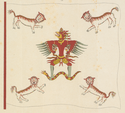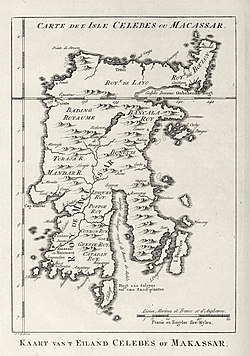Bone State
- View a machine-translated version of the Indonesian article.
- Machine translation, like DeepL or Google Translate, is a useful starting point for translations, but translators must revise errors as necessary and confirm that the translation is accurate, rather than simply copy-pasting machine-translated text into the English Wikipedia.
- Consider adding a topic to this template: there are already 296 articles in the main category, and specifying
|topic=will aid in categorization. - Do not translate text that appears unreliable or low-quality. If possible, verify the text with references provided in the foreign-language article.
- You must provide copyright attribution in the edit summary accompanying your translation by providing an interlanguage link to the source of your translation. A model attribution edit summary is
Content in this edit is translated from the existing Indonesian Wikipedia article at [[:id:Kesultanan Bone]]; see its history for attribution. - You may also add the template
{{Translated|id|Kesultanan Bone}}to the talk page. - For more guidance, see Wikipedia:Translation.
Sultanate of Bone ᨕᨀᨑᨘᨂᨛ ᨑᨗ ᨅᨚᨊᨛ Akkarungeng ri Bone (Buginese) | |||||||
|---|---|---|---|---|---|---|---|
| 14th century–1905; 1931–1950 | |||||||
 Flag | |||||||
 | |||||||
| Status | Part of Indonesia | ||||||
| Capital | Watampone | ||||||
| Common languages | Bugis | ||||||
| Religion | Sunni Islam | ||||||
| Government | Monarchy | ||||||
| Sultan, Arung Mangkaue' ri Bone | |||||||
• 1300s | Manurunge ri Matajang | ||||||
• 1358-1424 | Petta Panre Bessie | ||||||
• 1672-1696 | Sultan Saaduddin Arung Palakka | ||||||
• 1931-1946 | Andi Mappanyukki | ||||||
| History | |||||||
• Established | 14th century | ||||||
• Loss of independence to the Dutch | 1905[1] | ||||||
| |||||||
| Today part of | Indonesia (as Bone Regency) | ||||||
Bone (also Boni, or Bone Saoraja) was a sultanate in the south-west peninsula of what is now Sulawesi (formerly Celebes), a province of modern-day Indonesia. It came under Dutch rule in 1905, and was succeeded by the Bone Regency.[1]
Covering an area of 2,600 square kilometres (1,000 sq mi)[citation needed], Bone's chief town Boni, lay 130 kilometres (81 mi) northeast of the city of Makassar, home to the Bugis people.

History
Bone was an adat-based Bugis kingdom whose origins can be traced back to the early 15th century. Its chronicle (as yet unpublished) provides detailed information on its rulers, starting from La Umasa, who ruled in the early 15th century, through to La Tenrtatta, who died in 1699. Under La Umasa and his nephew La Saliu (Kerrépelua) who succeeded him, Bone expanded from a handful of settlements around the modern capital Watampone to a small kingdom roughly one-third the size of Kabupaten Bone (the present regency).
In the early 16th century the kingdom expanded northwards, fighting with Luwu for control of the mouth of the River Cenrana, a major east coast trade exit. In 1582 Bone entered an alliance with the Wajo and Soppeng kingdoms for mutual defence against the rising power of Gowa-Tallo. This alliance became known as Tellumpocco'e (lit. the Three Summits) or LaMumpatue Ri Timurung (lit. The burying of the stones at Timurung).[2]

In 1611, during the reign of the tenth king of Bone We Tenrituppu MatinroE ri Sidenreng, Bone was invaded by the Sultanate of Gowa and pressured to convert to Islam.[3][4] Bone State later enjoyed a period of prosperity in the middle of the 17th century.[2]
Bone became the most powerful state of South Sulawesi under Arung (ruler of) Palakka, La Tenritatta (1634 or 1635 – 1696) who sided with the Dutch admiral Cornelis Speelman against the Makasar kingdom of Gowa-Tallo, which led to the defeat and capture of Makassar in 1669. From this year until 1814 when the British temporarily gained power of the region, Bone was by treaty and in practice the overlord of South Sulawesi, with the exception of Dutch-controlled areas on the west and south coast, including the important port-city of Makassar. When the Dutch returned to Makassar in 1816 they attempted to reduce Bone's status from equal to vassal, a move strongly resisted by Bone's rulers.
Over the course of the 19th century, the power of Bone was reduced as a result of several wars waged against it in 1824, 1859, and 1905.[5] Following a military defeat during the South Sulawesi expeditions of 1905, the Bone State lost its independence to the Dutch.[6] Bone, along with Gowa, became under direct administration.[7]
In the late 1920s, the Dutch restored many royal rulers as a way to suppress the tide of nationalist sentiment. Bone was no exception; in 1931, Mappanyuki, a scion of both the houses of Gowa and Bone, was restored to his family's ancestral position in Watampone.[7]
In May 1950, the people held demonstrations in Watampone against the royalty and Bone's membership in the State of East Indonesia. This caused the sultan to join Indonesia.[4]
List of rulers
Rulers of Bone used the title Arung Mangkaue' ri Bone (the king who resides in Bone), shortened to Arumpone, MangkauE, or ArungE' ri Bone.
| No | Monarch | Gender | Reign |
|---|---|---|---|
| 1 | Manurung ri Matajang (Mata Silompoé) | Male | 1350 – 1366 |
| 2 | La Ummasa To'Mulaiyé Panra | Male | 1366 – 1398 |
| 3 | La Saliwu (Kerampelua) | Male | 1398 – 1470 |
| 4 | Wé Benrigau' Daéng Marawa, Mallajang' ri Cina | Female | 1470 – 1490 |
| 5 | Tenrisukki, Mappajungngé | Male | 1490 – 1517 |
| 6 | La Uliyo Botoé, Matinroé ri Itterung | Male | 1517 – 1542 |
| 7 | La Tenrirawe Bongkange, Matinroe ri Guccina | Male | 1542 – 1584 |
| 8 | La Ica, Matinroé ri Adénenna | Male | 1584 – 1595 |
| 9 | La Patawe, Matinroé ri Bettung | Male | 1595 – 1602 |
| 10 | I Dangka Wé Tenrituppu, Matinroé ri Sidénréng | Female | 1602 – 1611 |
| 11 | La Tenriruwa Arung Palakka (Sultan Adam Matinroé ri Bantaéng | Male | 3 months in 1611 |
| 12 | Tenripallé To'Akkeppeyang Arung Timurung, Paduka Sri Sultan 'Alauddin Matinroé ri Talloq | Male | 1611 – 1626 |
| 13 | La Maqdaremmeng, Paduka Sultan Muhammad Saleh Matinroé ri Bukaka | Male | 1626 – 1643 |
| 14 | La Tenriaji To'Senrima, Arung Awamponé Pawélaié ri Siang | Male | 1643 – 1645 |
| 13 | La Maqdaremmeng, Paduka Sultan Muhammad Saleh Matinroé ri Bukaka (restored) | Male | 1667 – 1672[9] |
| 15 | La Tenritatta To'Unru Malampéq-é Gemineqna Daéng Serang Arung Palakka, Paduka Sri Sultan Sa'aduddin Matinroé ri Bontoalaq | Male | 1672 – 1696 |
| 16 | La Patau Matanna Tikka Arung Palakka, Paduka Sri Sultan Idris Azimuddin Matinroé ri Nagauleng | Male | 1696 – 1714 |
| 17 | Batari Toja Daéng Talaga Arung Timurung, Datu Chitta Sultanah Zainab Zulkiyahtuddin Matinroé ri Tippulué | Female | 1714 – 1715 |
| 18 | La Paddasajati To'Appawareq Arung Palakka, Paduka Sri Sultan Sulaiman Matinroé ri Béula | Male | 1715 – 1718 |
| 19 | La Pareppa To'Soppéwali, Paduka Sri Sultan Shahabuddin Ismail Matinroé ri Somba Opu | Male | 1718 – 1721 |
| 20 | La Panaongi To'Pawawoi Arung Mampu Karaéng Bisei, Paduka Sri Sultan Abdullah Mansor Matinroé ri Bisei | Male | 1721 – 1724 |
| 21 | Batari Toja Daéng Talaga Arung Timurung, Datu Chitta Sultanah Zainab Zulkiyahtuddin Matinroé ri Tippulué (restored, 2nd reign) | Female | 1724 – 1738 |
| 21 | Batari Toja Daéng Talaga Arung Timurung, Datu Chitta Sultanah Zainab Zulkiyahtuddin Matinroé ri Tippulué (3rd reign) | Female | 1741 – 1749 |
| 22 | La Temmassongeq, Paduka Sri Sultan Abdul Razak Jalaluddin Matinroé ri Mallimongeng | Male | 1749 – 5 June 1775 |
| 23 | La Tenritappu, Paduka Sri Sultan Ahmad as-Saleh Syamsuddin Matinroé ri Rompegading | Male | 5 June 1775 – 1812 |
| 24 | La Mappatunruq, Paduka Sri Sultan Ismail Mokhtajuddin Matinroé ri Lalebbata | Male | 1812 – 1823 |
| 25 | I Maniratu Arung Data, Paduka Sri Sultanah Salehah Mahdi Rajiatuddin Matinroé ri Kessi | Female | 1823 – 1835 (12 years) |
| 26 | La Mappaseling Arung Panynyiliq, Sultan Adam Najamuddin Matinroé ri Salassana | Male | 1835 – 1845 |
| 27 | La Parénrengi Arung Punyi, Paduka Sri Sultan Ahmad Salleh Muhiyuddin Matinroé ri Adiyang Bénténg | Male | 1845 – 1857 |
| 28 | Pancaitana Bessé Kajuara Tenriawaru Matinroé ri Majennang | Female | 1857 – 1860 |
| 29 | Singkerru Rukka, Paduka Sri Sultan Ahmad Idris Matinroé ri To'Paccing | Male | 1860 – 1871 (11 years) |
| 30 | I Banrigau' Arung Timurung and Datu Chitta Paduka Sri Sultanah Fatimah Matinroé ri Bolampare'na | Female | 1871 – 1895 |
| 31 | La Pawawoi Arung Sijelling, Karaéng Sigeri Matinroé ri Bandung | Male | 1895 – 1905 |
| 32 | Andi La Mappanyukki Karaéng Selayar, Paduka Sri Sultan Ibrahim Matinroé ri Gowa | Male | 1931 – 1946 |
| 33 | Andi La Paqbénteng Daéng Palawa Arung Pitu and Arung Macégé Matinroé ri Matuju | Male | 1946 – 1950 |
See also
Citations
- ^ a b "South Sulawesi". 16 December 2022.
- ^ a b "Sejarah Kabupaten Bone". Website Resmi Pemerintah Kabupaten Bone (in Indonesian). 2019-12-05. Retrieved 2022-04-18.
- ^ Noorduyn, J. (1987). "Makasar and the Islamization of Bima". Bijdragen tot de Taal-, Land- en Volkenkunde. 143 (2/3): 312–342. doi:10.1163/22134379-90003330. JSTOR 27863842.
The Makasarese king understood the meaning of this and began what is known as the Islamic war, in Makasarese bunduq kasallannganga, by which he succeeded in the next four years in forcing the major Buginese kingdoms to accept Islam one by one, Bone as the last in 1611.
- ^ a b Pamelleri, Riwayat.
- ^ Gibson, Thomas (2005-03-31). And the Sun Pursued the Moon: Symbolic Knowledge and Traditional Authority among the Makassar. University of Hawaii Press. p. 191. ISBN 978-0-8248-7457-5.
- ^ Budiarti, Hari (2007). "Taking and Returning Objects in a Colonial Context: Tracing the Collections Acquired during the Bone-Gowa Military Expeditions". In Pieter J. ter Keurs (ed.). Colonial Collections Revisited. Leiden: CNWS Publications. p. 128.
- ^ a b Gibson, Thomas (2005-03-31). And the Sun Pursued the Moon: Symbolic Knowledge and Traditional Authority among the Makassar. University of Hawaii Press. pp. 182–3. ISBN 978-0-8248-7457-5.
- ^ Omar, Rahilah (2003-11-01). "The history of Boné A.D. 1775-1795: the diary of Sultan Ahmad as-Salleh Syamsuddin".
{{cite journal}}: Cite journal requires|journal=(help) - ^ "The heritage of Arung Palakka : a history of South Sulawesi (Celebes) in the seventeenth century". Library of Congress, Washington, D.C. 20540 USA. Retrieved 2024-04-05.
References
- For the wars in Boni, see Perelaer, De Bonische Expedition, 1859 (Leiden, 1872) (in Dutch); and Meyers, in the Militaire Spectator (1880).
- Chisholm, Hugh, ed. (1911). "Boni" . Encyclopædia Britannica. Vol. 4 (11th ed.). Cambridge University Press. pp. 205–206.
- Pamelleri, Andi (22 April 2006). "Riwayat Kabupaten Bone" [A Short History of Bone Regency] (PDF) (in Indonesian). Archived from the original (PDF) on 30 August 2019. Retrieved 23 August 2011.
- "South Sulawesi". 16 December 2022.
Further reading
- Macknight, C.; Paeni, M.; Hadrawi, M., eds. (2020). The Bugis Chronicle of Bone. Acton ACT: ANU Press. doi:10.22459/bcb.2020. ISBN 978-1-76046-357-1.













